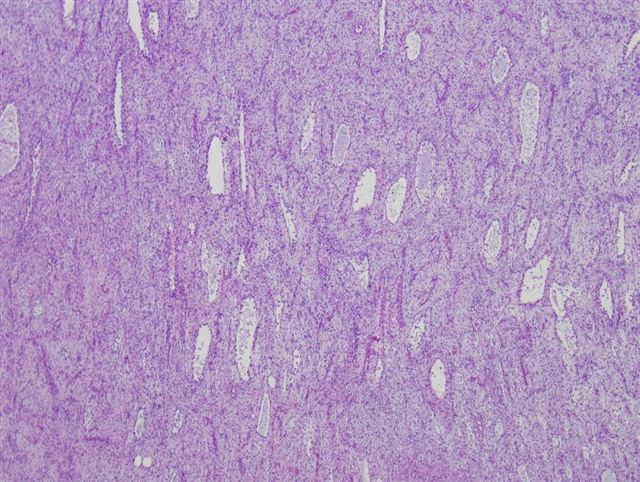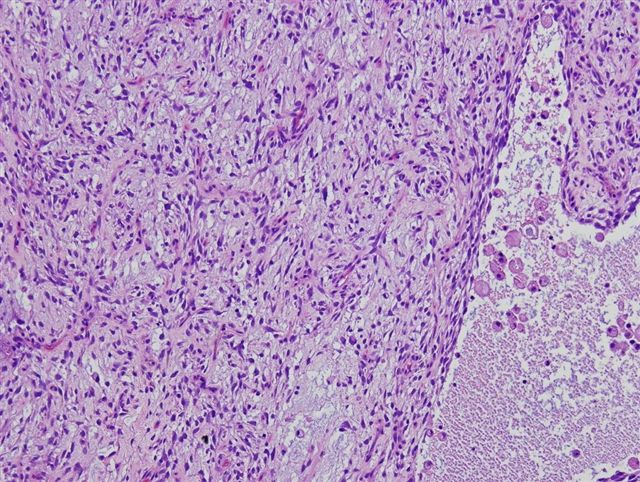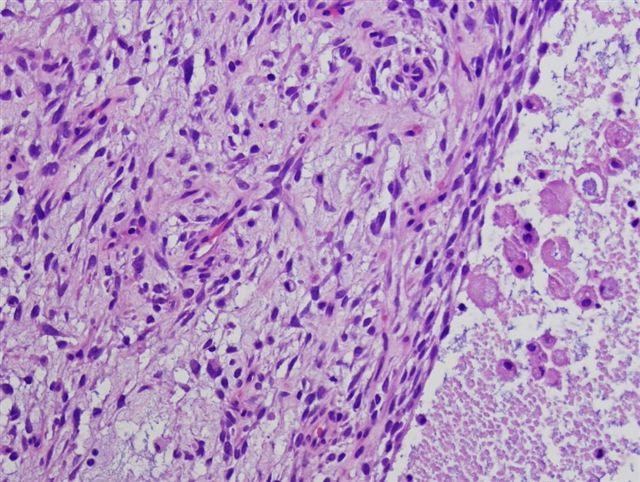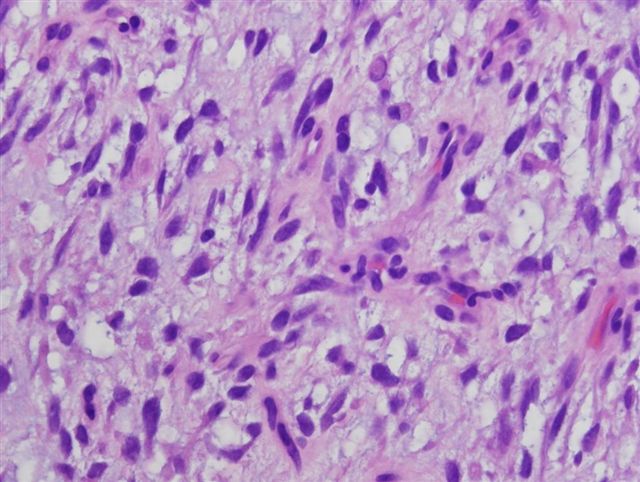22 October 2008 - Case #132
All cases are archived on our website. To view them sorted by case number, diagnosis or category, visit our main Case of the Month page. To subscribe or unsubscribe to Case of the Month or our other email lists, click here.
This case was contributed by Dr. Daniel Ostler, Anderson Cancer Center, Houston, Texas (USA).
Case #132
Clinical history:
A 54 year old woman had a right supraclavicular mass, which clinically resembled a lymph node.
Microscopic images:
What is your diagnosis?
Diagnosis: Dermatofibrosarcoma protuberans (DFSP), myxoid variant
Discussion:
The microscopic images show a sheet-like proliferation of relatively bland spindle cells that infiltrate the adjacent fat, in a myxoid stroma. Numerous thin walled vessels are present. The spindle cells have pale eosinophilic cytoplasm and stellate nuclei without pleomorphism. The tumor cells were immunoreactive for CD34 (images not provided).
The myxoid variant of DFSP is defined as having at least 50% myxoid stroma. It is an uncommon variant but has the same prognosis as classic DFSP (Am J Surg Pathol 2007;31:1371). The tumor cells are immunoreactive for CD34 and negative for S100 and muscle markers.
The differential diagnosis includes benign and malignant tumors. Myxoid neurofibroma has wavy nuclei and often intratumoral axons. It is strongly S100 positive. Superficial angiomyxoma also has a myxoid stroma with numerous small vessels and may be CD34 positive. However, it does not infiltrate fat and tends to be less cellular. Myxoid liposarcoma has vessels that are more abundant, delicate and branching than the vessels of myxoid DFSP. In addition, lipoblasts are prominent.
Treatment of myxoid DFSP, like classic DFSP, consists of complete excision. The prognosis is good, with only occasional recurrences (Am J Dermatopathol 2007;29:443).
All cases are archived on our website. To view them sorted by case number, diagnosis or category, visit our main Case of the Month page. To subscribe or unsubscribe to Case of the Month or our other email lists, click here.
This case was contributed by Dr. Daniel Ostler, Anderson Cancer Center, Houston, Texas (USA).
Website news:
(1) We have two new email lists. First, every two weeks, we send subscribers a list of new fellowships posted at our website. Second, we have a monthly email about our charity, The Detroit College Promise. To subscribe, click here.
(2) By request, we are adding a section on Board Review Questions. If you have sample questions and answers, just email them to us.
(3) We have an Other Laboratory Jobs page, which includes PAs, cytotechs, med techs, histotechs, managers, etc., and now includes related corporate jobs, such as sales.
Visit and follow our Blog to see recent updates to the website.
(1) We have two new email lists. First, every two weeks, we send subscribers a list of new fellowships posted at our website. Second, we have a monthly email about our charity, The Detroit College Promise. To subscribe, click here.
(2) By request, we are adding a section on Board Review Questions. If you have sample questions and answers, just email them to us.
(3) We have an Other Laboratory Jobs page, which includes PAs, cytotechs, med techs, histotechs, managers, etc., and now includes related corporate jobs, such as sales.
Visit and follow our Blog to see recent updates to the website.
Case #132
Clinical history:
A 54 year old woman had a right supraclavicular mass, which clinically resembled a lymph node.
Microscopic images:
What is your diagnosis?
Click here for diagnosis and discussion:
Diagnosis: Dermatofibrosarcoma protuberans (DFSP), myxoid variant
Discussion:
The microscopic images show a sheet-like proliferation of relatively bland spindle cells that infiltrate the adjacent fat, in a myxoid stroma. Numerous thin walled vessels are present. The spindle cells have pale eosinophilic cytoplasm and stellate nuclei without pleomorphism. The tumor cells were immunoreactive for CD34 (images not provided).
The myxoid variant of DFSP is defined as having at least 50% myxoid stroma. It is an uncommon variant but has the same prognosis as classic DFSP (Am J Surg Pathol 2007;31:1371). The tumor cells are immunoreactive for CD34 and negative for S100 and muscle markers.
The differential diagnosis includes benign and malignant tumors. Myxoid neurofibroma has wavy nuclei and often intratumoral axons. It is strongly S100 positive. Superficial angiomyxoma also has a myxoid stroma with numerous small vessels and may be CD34 positive. However, it does not infiltrate fat and tends to be less cellular. Myxoid liposarcoma has vessels that are more abundant, delicate and branching than the vessels of myxoid DFSP. In addition, lipoblasts are prominent.
Treatment of myxoid DFSP, like classic DFSP, consists of complete excision. The prognosis is good, with only occasional recurrences (Am J Dermatopathol 2007;29:443).





